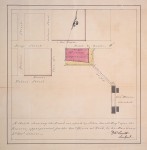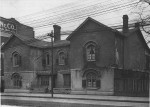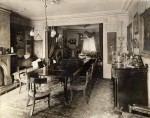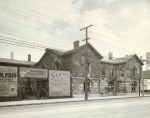 If there’s even a temporal disturbance in the future 17-story Globe and Mail Centre, the Toronto newspaper will have a front-row seat to one of the juiciest, most sensational stories in the city’s history. The new tower will be constructed on a 10-block grid on King Street East in the oldest part of Toronto, the former town of York. Because of the age of the site, city regulations require an archaeological survey before construction can begin. Two weeks ago, archaeologists unearthed brick foundation walls, masonry, beams, a backyard privy and a smattering of artifacts that date to the earliest days of British Toronto.
If there’s even a temporal disturbance in the future 17-story Globe and Mail Centre, the Toronto newspaper will have a front-row seat to one of the juiciest, most sensational stories in the city’s history. The new tower will be constructed on a 10-block grid on King Street East in the oldest part of Toronto, the former town of York. Because of the age of the site, city regulations require an archaeological survey before construction can begin. Two weeks ago, archaeologists unearthed brick foundation walls, masonry, beams, a backyard privy and a smattering of artifacts that date to the earliest days of British Toronto.
These are the remains of Berkeley House, a structure that began life as a modest hewn timber house in 1794, just a year after Governor John Graves Simcoe established the town of York. The house, one of the first permanent dwellings in the settlement, was bought for $50 in 1795 by Major John Small, a well-connected British militia officer who served as clerk of the Executive Council of Upper Canada under Governor Simcoe. When Small bought the one-acre lot, it was just outside the perimeter of York’s nascent street grid, but because of his friends in high places, he got the grid extended to cover his lot. It stands out on early maps, the jutting property attached to the original grid giving it an irregular shape.
 The man who drew those early maps, Surveyor General David William Smith, played in a pivotal role in a scandal which would ensure John Small’s place in Toronto history. It all started with a party snub. At a ball celebrating the turn of the century in late 1799, Mrs. Small, née Elizabeth Goldsmith, publically slighted the wife of Attorney General John White. Marrianne White was notoriously hard to get along with. She and her husband had separated twice and she actually took their daughter and returned to England shortly after that fateful party.
The man who drew those early maps, Surveyor General David William Smith, played in a pivotal role in a scandal which would ensure John Small’s place in Toronto history. It all started with a party snub. At a ball celebrating the turn of the century in late 1799, Mrs. Small, née Elizabeth Goldsmith, publically slighted the wife of Attorney General John White. Marrianne White was notoriously hard to get along with. She and her husband had separated twice and she actually took their daughter and returned to England shortly after that fateful party.
Still, York society was tiny at this time — the total population was 400 souls, with maybe 75 of them establishment grandees — and mighty contests rose from trivial things. In response to the slight, John White wrote to David William Smith that Mrs. Small was just bitter because White had hit it and quit it, to coin a phrase. He broke up with her, White told Smith, out of concern for his health given “the variety and piquancy of her amours with others.”
 Mr. Smith did not sit on this information. He promptly spread it to the wife of Chief Justice John Elmsley who spread it to everyone else. Within days, word of White having basically called his wife a syphilitic whore got back to John Small. He wasted no time in seeking satisfaction and on January 3rd, 1800, the Attorney General and the clerk of the Executive Council of Upper Canada faced each other behind the Parliament buildings, pistols in hand. Small shot White through the ribs. It was a fatal blow, although it would take the poor man 36 hours of what must have been excruciating pain to die.
Mr. Smith did not sit on this information. He promptly spread it to the wife of Chief Justice John Elmsley who spread it to everyone else. Within days, word of White having basically called his wife a syphilitic whore got back to John Small. He wasted no time in seeking satisfaction and on January 3rd, 1800, the Attorney General and the clerk of the Executive Council of Upper Canada faced each other behind the Parliament buildings, pistols in hand. Small shot White through the ribs. It was a fatal blow, although it would take the poor man 36 hours of what must have been excruciating pain to die.
Small was arrested and tried for murder on January 25th. Presiding Judge Henry Allcock, a close friend and colleague of Chief Justice Elmsley and of the slain Attorney General, was openly hostile to Small, but that wasn’t sufficient to secure a guilty verdict. The trial lasted just eight hours and Small was acquitted because no witnesses came forward to say they had seen him fire the fatal shot. (The district sheriff was his second at the duel, which may explain the lack of witnesses.)
 What the law could not do, York society did. Small and his wife were shunned by all the top families who had once been their friends. He kept his job, but all his attempts to run for office were thwarted by his social enemies. A full eight years after the duel, an invitation to Mrs. Small to attend the governor’s New Year’s Day levee still caused grumbling among the upper crust.
What the law could not do, York society did. Small and his wife were shunned by all the top families who had once been their friends. He kept his job, but all his attempts to run for office were thwarted by his social enemies. A full eight years after the duel, an invitation to Mrs. Small to attend the governor’s New Year’s Day levee still caused grumbling among the upper crust.
The Smalls’ social decline didn’t impede his success in business, however. By 1797 John Small had acquired more than 2,500 acres of land in York. He sold some lots and bought others, and as the city grew, he prospered from his investment real estate. By 1820 land prices were sky high and John Small was one of the wealthiest men in town. He rebuilt his log cabin into a manor house with twin gables and gave it the noble-sounding name of Berkeley House.
 John Small died in 1831 and bequeathed the house to his son Charles Coxwell Small. Charles added wings in the 1840s. He died in 1864 and by 1870 Berkeley House had been divided into three homes. Meanwhile, that original one acre lot had been subdivided with parcels sold to, among other outfits, a lumber mill and a grain elevator, which left Berkeley House with some less than pleasant neighbors. By the 1920s, the house was derelict with chunks of falling stucco and rotten wood everywhere. In 1925 it was demolished. Since then, there’s been no construction on the site other than a parking lot.
John Small died in 1831 and bequeathed the house to his son Charles Coxwell Small. Charles added wings in the 1840s. He died in 1864 and by 1870 Berkeley House had been divided into three homes. Meanwhile, that original one acre lot had been subdivided with parcels sold to, among other outfits, a lumber mill and a grain elevator, which left Berkeley House with some less than pleasant neighbors. By the 1920s, the house was derelict with chunks of falling stucco and rotten wood everywhere. In 1925 it was demolished. Since then, there’s been no construction on the site other than a parking lot.
Little of the house’s material culture remains. Keith Powers and his team have unearthed inkwells, an 1880 gravy boat, an 1882 plate pilfered from the Albany Club and an evocative Bank of Montreal penny decorated with an English rose, a Scottish thistle and an Irish shamrock.
“It grounds you to the family who lived here,” he said as he turned the oversized coin in the morning light. “This was dropped by one of the Smalls and no one has held it for more than a hundred years.”
The artifacts unearthed during the survey and parts of the walls and foundations will be integrated into the public areas of the Globe & Mail Centre. Sadly the architectural elements will not be preserved in situ. Whatever is deemed worthy of display will be removed and the rest will be destroyed when the new building goes up.
You left the bodies and you only moved the headstones!! YOU ONLY MOVED THE HEADSTONES!!!
This post contains the most detail I’ve been able to find (via the internet, or any of the books I’ve thus far consulted) on the matter of the duel. Thank you! Would you be able to share your sources?